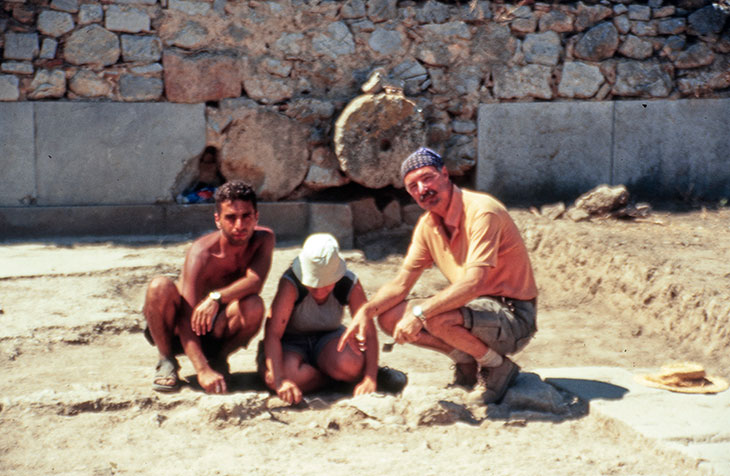The British Museum curator Ian Jenkins and I were unlikely allies. I remember, as a postgraduate student, thinking him terrifying – not just academically conservative (everyone whose heels I was snapping at in those days was liable to that charge) but potentially disapproving. Sixteen years later, he and I were going through the draft of my book Classical Art: a Life History in his tiny office in the British Museum, paper everywhere. He was the only specialist in Greek art, other than my husband, whose (dis)approval I had sought on the whole book – and his advice was invaluable. He was a treasure trove of information, and gloriously irreverent with it. I gained more expansive vistas on all sorts of things – from classical sculpture to Hadrian’s hellenism to classicism in China, not to mention the merits of my typescript vis-à-vis others he was reading, and was ticked off for my ‘mild tendency to construct complex sentences’. I often think of Ian when I write, and was at my laptop revising my latest book when news of his passing reached me. He had long suffered from Parkinson’s disease, and died suddenly on 28 November.
Truth was that he and I were natural allies: he had commissioned me to write Sex on Show: Seeing the Erotic in Greece and Rome (2013), and shared the stage with me at many a conference and lecture. He also showed my students around the museum. I will never forget being in the basement, long after we should have been at the Sir John Soane’s Museum – Ian in full flow, everyone completely captivated. I will also never forget the joint tour we gave to the trustees of the British Museum at the Museum of Classical Archaeology in Cambridge, egging each other on as the focus moved to the statues’ bottoms.
Ian shone when he talked, and made everyone and everything around him shine more brightly. Such was his charisma that one easily underestimated the knowledge underpinning it. Mention his name, and it is the Parthenon sculptures one tends to think about, controversial questions eloquently handled. His ‘picture book’ on them (2007) supports his more specialist contributions (on their meaning, casting, polychromy, cleaning) to exemplify a commitment not only to public dissemination, but also to beauty, and to Greece. In a world in which beauty and the canon have become unfashionable at best, he was one of their greatest advocates, unafraid to celebrate the subjective response, and to admit that no matter how impartial we try to be, what ancient objects are is tied up with what they have become; with how they make us feel.
Ian Jenkins and colleagues on excavation at Cnidos. © 2020 Trustees of the British Museum

The Parthenon was but the tip of the iceberg for Ian. Indicative of his range as a classical archaeologist is his book Greek Architecture and its Sculpture (2006), and his article on alabaster statuettes from Naucratis in the Nile Delta, written during his tenure of the Samuel H. Kress lectureship in Ancient Art. Both draw extensively on the British Museum’s holdings, deploying them to ask big questions. Both also open with modernity and with the Enlightenment and Renaissance, and 19th-century excavation, respectively. For Ian, production and reception were as interlinked as the Museum and the Academy.
I can think of few curators of Greek and Roman art who have done more with the collection in their charge. As he said in an email to me when I first asked him to talk to my students: ‘I am used to explaining the Museum as a grand story in reception studies.’ As ever, this was an understatement. Perhaps his most influential book, Archaeologists & Aesthetes: In the Sculpture Galleries of the British Museum 1800–1939 (1992), is about the ways in which the museum’s acquisition and display of classical sculpture were shaped by the relationship of art to the emerging field of archaeology, and of Greece and Rome to Assyria, Egypt, Persia. But for anyone interested in the history of collecting, his co-curation of exhibitions at the British Museum made just as much of a difference. Of these, ‘Defining Beauty: the Body in Ancient Greek Art’ (2015) was Ian at his most comfortable. ‘Vases and Volcanoes: Sir William Hamilton and his Collection’ (1996) and, in creative collaboration with the Musée Rodin in Paris, ‘Rodin and the Art of Ancient Greece’ (2018) constituted some of his best work. He was perhaps strongest in dialogue, and – though his modesty would have had him beg to differ – as ahead of his time in some things as he was conservative in others. He understood the importance of making each exhibition question-led; the joy of the argument, the magnificence of the material. Small wonder that when asked about working with the British Museum, Grayson Perry highlighted time spent with ‘the brilliant and funny Ian Jenkins’. ‘I still don’t like classical statues,’ Perry admitted. I imagine Ian intent – even now – on persuading him otherwise.
Caroline Vout is Professor of Classics at the University of Cambridge and Byvanck Chair of Classical Archaeology at Leiden University. Her response to the Rodin catalogue, ‘Rodin’s complicated relationship with classical art’, can be found here.


